Physical Address
304 North Cardinal St.
Dorchester Center, MA 02124
Upper limb contour is often of great concern to individuals following weight loss and some older women.
Correction of contour deformities of the axilla and forearm and in some instances the lateral thoracic region as well as the arm are critical to maximizing the aesthetics of the upper extremity.
Liposuction often plays an important role in brachioplasty.
Scar placement is an important element of upper extremity contouring.
Upper limb contouring is associated with few serious complications.
![]()
![]() Access video and video lecture content for this chapter online at Elsevier eBooks+
Access video and video lecture content for this chapter online at Elsevier eBooks+
The rapid growth in bariatric surgery over the past two decades has led to an increase in demand for surgical procedures to address the contour deformities of the arm following weight loss. According to the American Society of Plastic Surgeons, from 2000 to 2020 there was a 4174% increase in the number of brachioplasty procedures performed in the US. While weight loss and aging affect the entire body, for some individuals, the arms are of greatest concern because of their visibility in everyday activities. The combination of a patient desire for improved aesthetics and function and the ready visibility of the arms in routine activities creates a special challenge for plastic surgeons considering upper limb contouring.
The arm deformity associated with weight loss is often dramatic and is influenced by multiple factors, including patient body mass index (BMI), highest BMI ever obtained, change in BMI, age, and sex ( Figs. 36.1–36.5 ). In the morbidly obese individual, fat deposits are usually most prominent along the posterior aspect of the arm with smaller deposits along the axilla, anterior, lateral and medial arm (see Fig. 36.1 ). With weight loss, these regions of the upper extremity manifest the greatest excess in soft tissue. Patients presenting at a lower BMI, and particularly those who had reached a very high BMI prior to weight loss, are likely to have more soft-tissue excess than an individual who has had smaller change in weight (see Figs. 36.2 & 36.3 ). Patients in their fifth decade and beyond, particularly women, perhaps because of attenuated connective tissue, often present with large amounts of excess tissue despite relatively small changes in BMI (see Fig. 36.4 ). Men tend to have the majority of their deformity limited to the proximal arm and axilla (see Fig. 36.5 ). Women may have this appearance as well, but are more likely to have a deformity extending to the elbow and forearm (see Fig. 36.4 ).
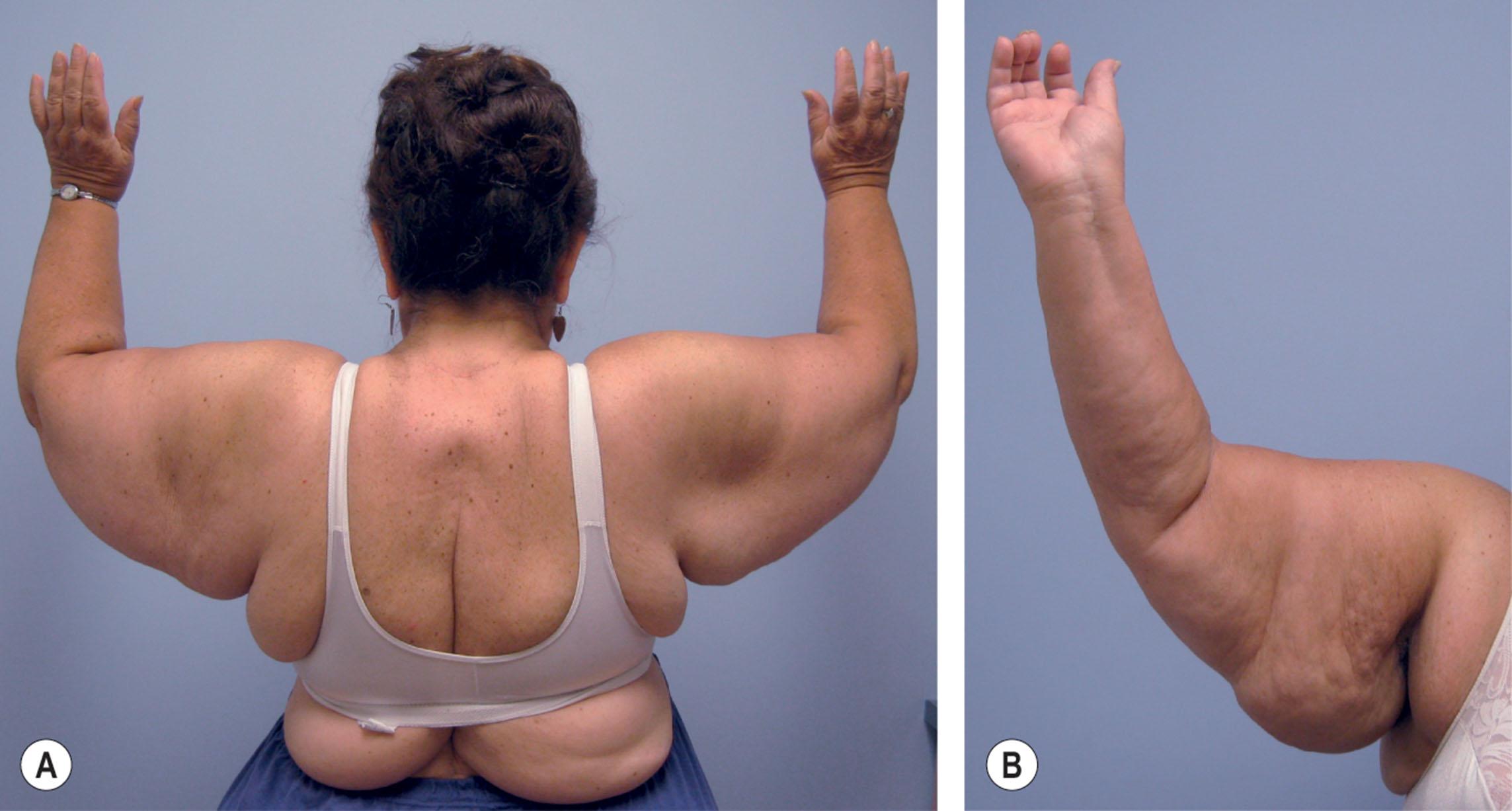
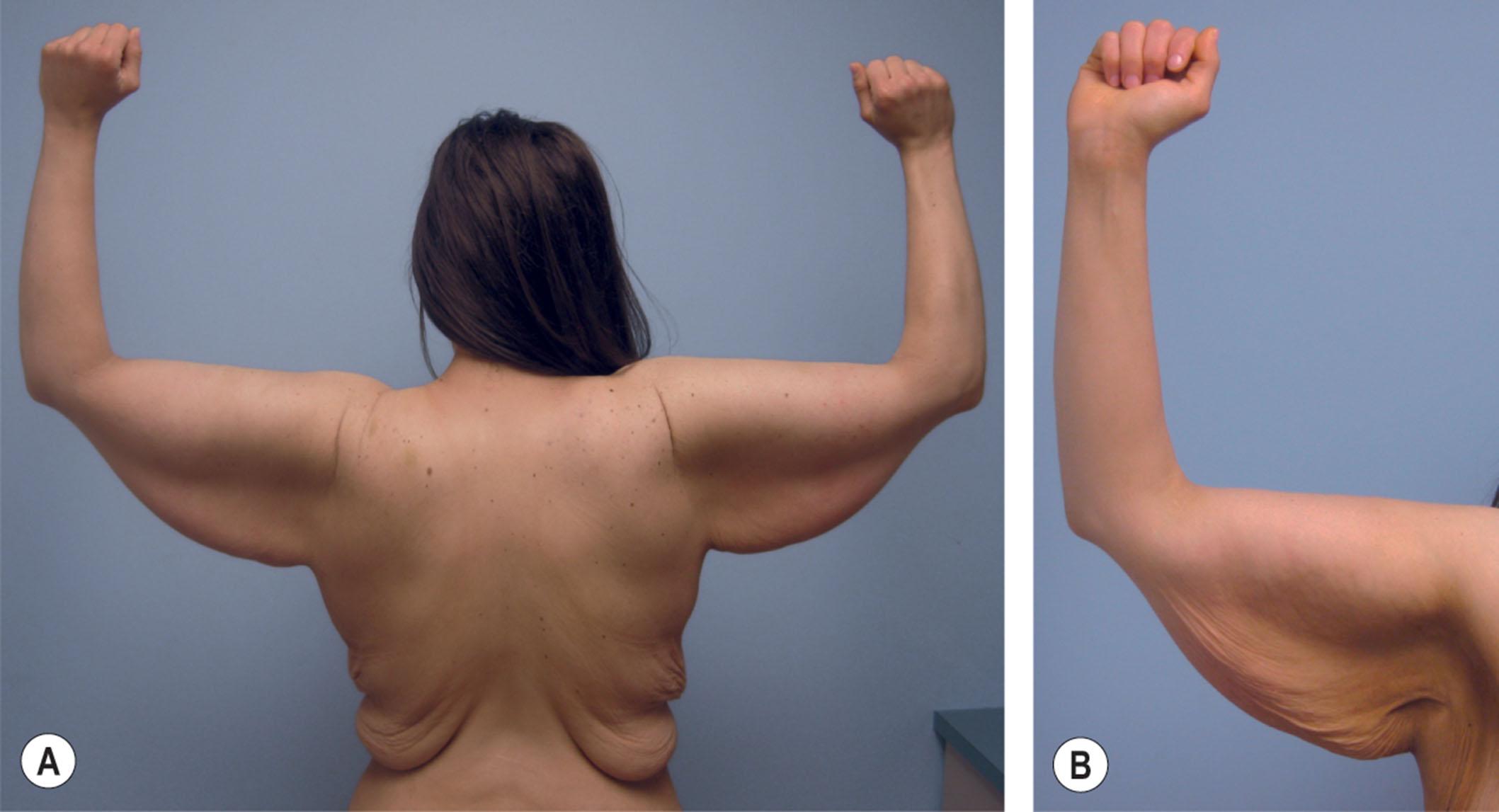
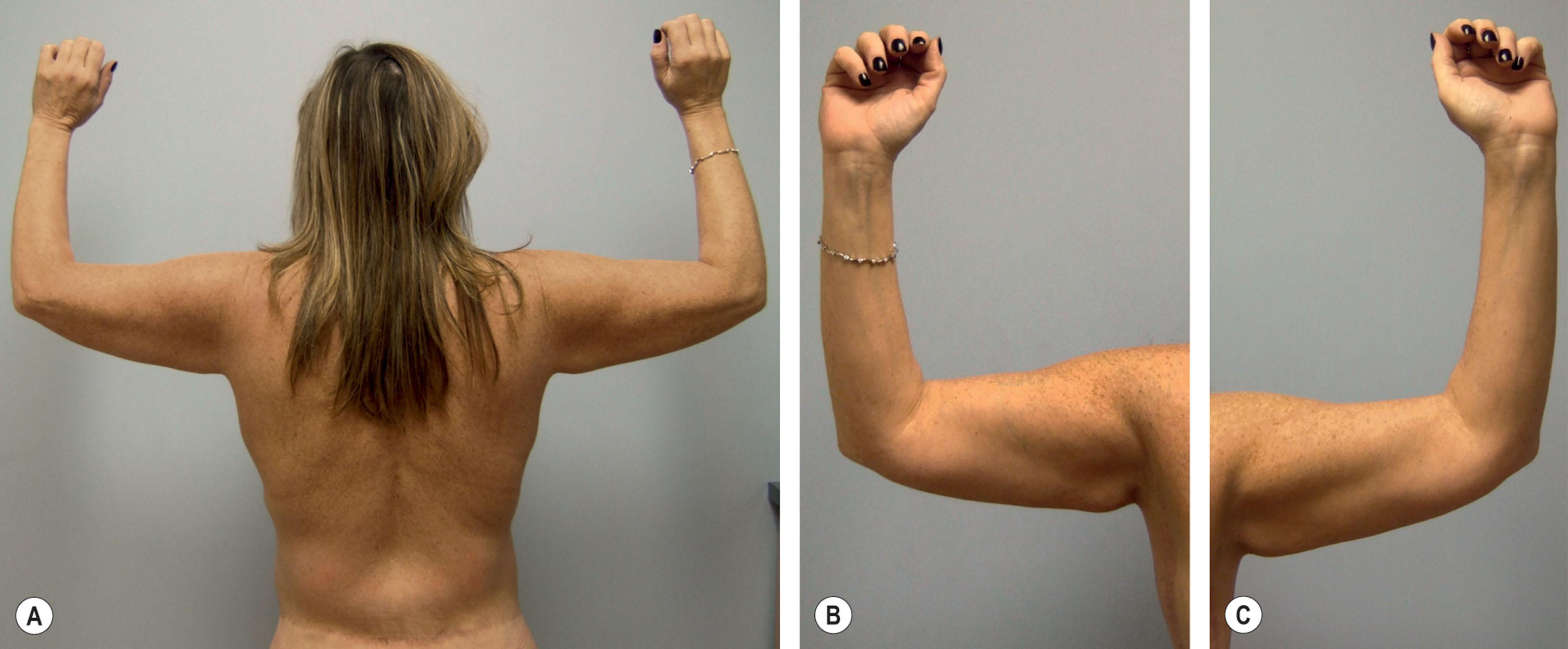
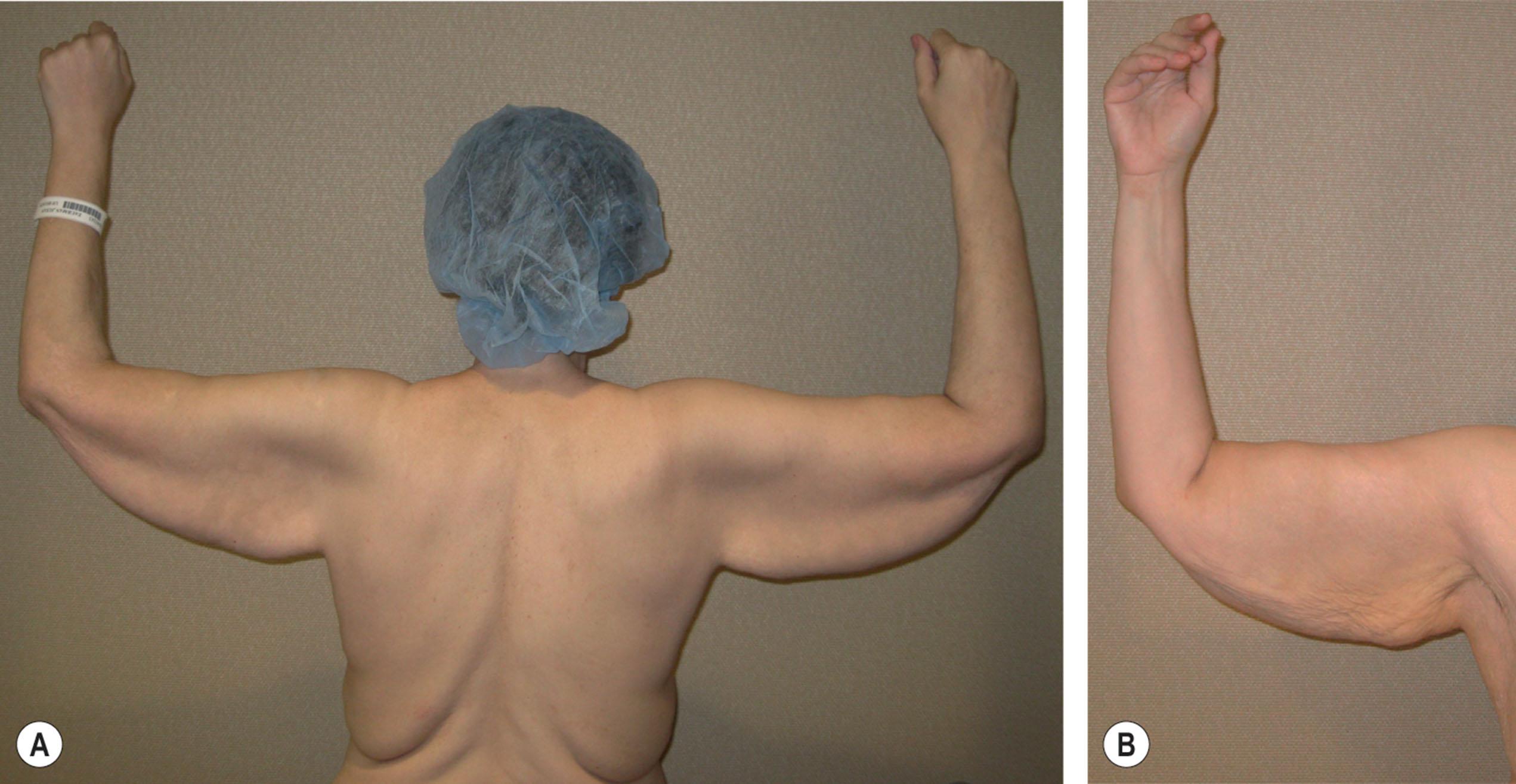
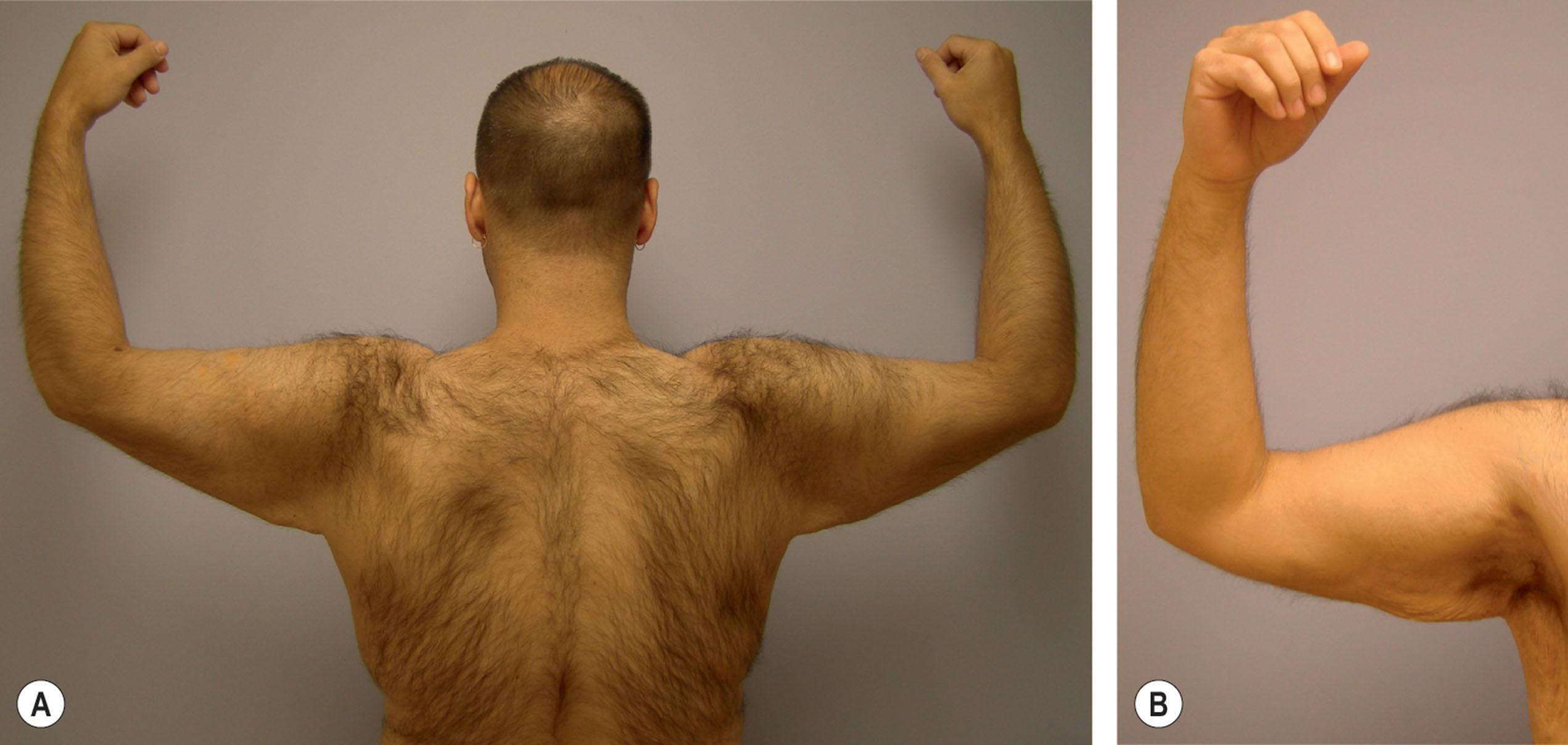
For some individuals, following weight loss and with aging, the arms are of primary and sole concern. More often, however, the arms are one of many concerns. Specific to the upper limb, patients usually present with multiple complaints, including a “bat-winged” appearance, arm stretch marks, large size of the arm relative to the forearm, excess skin and fat at the axilla and lateral thoracic region, and, for some individuals, loose skin along the proximal forearm. Recurring functional complaints are fatigue when elevating the arms and having to buy oversized clothing to accommodate disproportionately large arms. On occasion, an individual will complain of intertrigo at the axilla
The average age in our post-bariatric population is 39 and 63 in our non-post-bariatric population. Most of these individuals are very active and eager to minimize time off work and time away from family obligations. It is therefore quite common for a patient who expresses concerns about multiple areas of the body to request that all areas be addressed as soon as possible. One of the most important components of patient assessment is determining in what order and with what other procedures a brachioplasty should be performed. The patient's goals should be carefully considered in formulating a plan. With regard to the arm specifically, it is important to gain a clear understanding from patients of their tolerance for scars and of the degree of contour improvement they are expecting. A post-bariatric patient anticipating an optimal result from a procedure limited to the proximal arm is likely to be disappointed.
Prior to the year 2000, brachioplasty procedures were rarely performed by most plastic surgeons. The earliest descriptions of brachioplasty were relatively simple techniques involving the removal of an ellipse of soft tissue. The axilla was not addressed, and candidates for surgery were usually moderately overweight individuals. In the 1970s, multiple articles were published that described different patterns of arm soft-tissue excision. Several of these publications included techniques to avoid scar contracture at the arm/axilla transition. Pitanguy specifically described addressing deformities of the axilla and lateral thoracic region along with the arm. The first case report of a massive weight loss patient undergoing brachioplasty was published in this period. In the 1980s, techniques were described to perform brachioplasty as part of an upper bodylift and near-total bodylift, and Goddio reported on an innovative technique of burying soft-tissue excess.
Brachioplasty continued to evolve in the 1990s. Liposuction became a more integral component of these procedures, and Lockwood proposed that the posteromedial soft tissue of the arm be suspended to the clavipectoral periosteum by means of the clavipectoral fascia and axillary fasciae. He argued that when these structures loosen, they lead to a “loose hammock” effect or arm ptosis. Lockwood's technique for brachioplasty described securing the arm flap to the axillary fascia and the incorporation of a superficial fascial system repair of incisions to help reduce the incidence of wide scars and unnatural contours.
In the past two decade, numerous articles have been written on brachioplasty. In an effort to minimize scar length, several authors have described excisional techniques limited to the axilla and proximal arm in combination with liposuction. The majority of more recent articles and symposia on brachioplasty have involved almost exclusively the weight loss patient, and the size of the series analyzed has increased considerably. Much of the discussion today in the literature is on scar position, the timing and use of liposuction, and the incorporation of short scar techniques in the management of the post-bariatric patient.
Our preference is to utilize a posteromedial approach with extension to the medial epicondyle in combination with liposuction in the vast majority of our patients. In the first one-third of our series, scars were placed along the bicipital sulcus. We have not found an approach limited to the axilla or proximal arm to be effective in a significant number of individuals in this patient population.
Become a Clinical Tree membership for Full access and enjoy Unlimited articles
If you are a member. Log in here